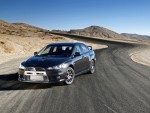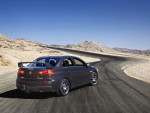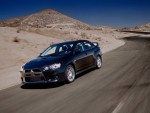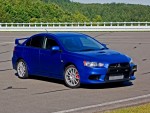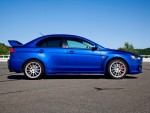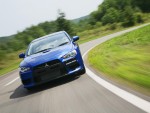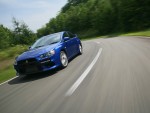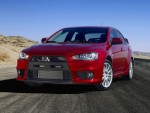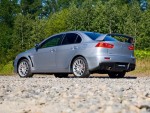2008 Mitsubishi Lancer Evolution X
2008 Mitsubishi Lancer Evolution X Pictures & Specifications
Home »
Mitsubishi
Picture Gallery
Technical Specifications
Make: Mitsubishi
Model: Lancer Evolution X
Engine: 2.0 litre four-cylinder
Aspiration: Turbocharged
Maximum Power: 291 hp (217 kW) @ 6500 rpm
Maximum Torque: 300 lb-ft (406 Nm) @ 4400 rpm
Transmission: Five-speed manual or six-speed automated manual (TC-SST)
Drivetrain: All-wheel drive
2008 Mitsubishi Lancer Evolution X
Mitsubishi Motors Press Release
22 February 2008
Mitsubishi Motors is introducing the 2008 Lancer Evolution, the newest and most sophisticated version of the legendary high-performance model series that began 16 years ago. While remaining true to the core values that have made the Lancer Evolution synonymous with thrilling performance, the next-generation model offers all-around capability and user technology that distinguish the world’s best performance models.
The strikingly styled 2008 Lancer Evolution showcases new performance and handling technology, including an all-new 291-hp 2.0-litre turbocharged and intercooled engine and the Super-All Wheel Control (S-AWC) dynamic handling system. S-AWC offers an extraordinary level of control at each wheel, going well beyond the capabilities of other all-wheel drive systems.
Two Lancer Evolution models will be offered in the U.S. market for 2008: the GSR with a new 5-speed manual transmission and the Lancer Evolution MR with a new 6-speed Twin-Clutch Sportronic Shift Transmission (TC-SST), a new-generation automated manual transmission. The MR model is also equipped exclusively with Bilstein shock absorbers and Eibach springs, two-piece brake rotors for better heat dissipation, BBS forged-alloy wheels, HID headlamps and additional interior features. Significantly, the newest Lancer Evolution will have less differentiation from market to market than the previous generations.
“The high-performance engine, sports car handling dynamics and striking design of the 2008 Lancer Evolution will appeal to enthusiasts worldwide – for those who desire a daily driver with street credentials as well as those planning weekend track action,” said Dan Kuhnert, vice president for marketing and sales, Mitsubishi Motors North America.
Design Evolution
The 2008 Lancer Evolution design makes a maximum performance statement, blending concept car themes and sound aerodynamic principles while conveying the brand’s rally heritage. A shark-nosed front end inspired by jet fighter air intakes, a distinct wedge-like profile and crisp, taut lines highlight the basic new-generation Lancer design. Building on those themes, the 2008 Lancer Evolution looks the part of the street-wise sports machine with its a unique front end, aggressively sloping hood with integral air scoop and engine heat outlets, boxed fenders, and 18-inch alloy wheels with Brembo brakes.
Inside, the Lancer Evolution presents a “class up” approach and shows a new international flair. Available user technology, including high-end Rockford Fosgate audio and navigation systems, reflects the tastes of a broadening customer base.
All-New 2.0-Litre Turbo Engine
The 2008 Lancer Evolution’s 4B11 engine is an intercooled-turbocharged 2.0-litre DOHC inline 4-cylinder. Beyond that description, it differs greatly from the legendary 4G63 it replaces. The 4B11 is built with a reinforced cast-aluminium cylinder block versus the cast-iron block used in the 4G63, and aluminium is also used for the cylinder head and cover and the timing chain case. Unlike the 4G63, the 4B11 does not use a balancer shaft, made possible by the new engine’s inherently lower noise and vibration and use of hydraulic engine mounts.
The new 4B11 T/C produces more power than its predecessor: 291 hp at 6,500 rpm (versus 286 hp at 6,500 rpm) and 300 lb-ft of peak torque at 4,400 rpm (versus 289 lb-ft at 3,500 rpm). The 4B11 T/C provides a broader torque curve, as well. A revised turbocharger yields up to 20-percent quicker response at lower engine speeds versus the 2006 engine’s turbocharger.
A major divergence from the previous engine architecture is in the use of a direct-acting valvetrain in place of the roller rocker arm configuration for reduced weight. A timing chain replaces the belt, and MIVEC variable valve timing us used on both the intake and exhaust camshafts (the most recent 4G63 had MIVEC on the intake only). The rear-located (firewall side) stainless steel exhaust manifold helps improve weight distribution, and the freer-breathing exhaust system features a larger-volume main muffler with dual tailpipe outlets.
New TC-SST Automated Manual Transmission
Exclusive to the Evolution MR model for 2008, the 6-speed Twin-Clutch Sportronic Shift Transmission (TC-SST) is an automated manual transmission capable of executing lightning-quick upshifts with no drop-off in engine power. The TC-SST features both a console-mounted shifter and magnesium steering wheel paddle shifters and offers manual and fully automatic modes.
Essentially, the TC-SST is a manual transmission that can select two gears at a time: one gear is engaged by one of the two wet multi-plate clutches, and the other is pre-selected, awaiting to be engaged by the second clutch. The gear change is made – either manually or automatically depending on mode selected – when the electro-hydraulically operated clutches are “swapped,” which occurs simultaneously, with no perceptible lag time.
The TC-SST offers three drive modes – Normal, Sport and S-Sport – and within each, the driver may choose automatic or manual shifting. Sport mode uses higher shift points (in Automatic) and quicker shifting to deliver instant throttle response for better performance feel. Sport mode is also useful for driving in mountainous areas or when engine braking is required. The S-Sport mode can be selected for performance driving situations, such as track events.
Super-All Wheel Control (S-AWC)
In the 2008 Mitsubishi Lancer Evolution, Super All-Wheel Control (S-AWC) is not simply the name of a new all-wheel drive system. Rather, S-AWC regulates drive torque at each wheel by controlling a network of dynamic handling technologies, including: Active Center Differential (ACD) 4-wheel drive, Active Yaw Control (AYC) rear differential, Active Stability Control (ASC), and Sports ABS brakes. Integration of ASC is new for all markets and also provides a significant advance in both dynamic capability and safety.
The ACD splits torque up to 50:50 between the front and rear wheels using an electronically controlled hydraulic multi-plate clutch. With input from the S-AWC computer, ACD regulates the differential limiting action to optimise the front/rear wheel torque split.
The S-AWC computer takes data input from steering wheel angle, throttle opening, wheel speeds, and the vehicle’s longitudinal and lateral movements to determine the vehicle’s path of travel. As the previous Lancer Evolution did, the 2008 model offers three driver-selectable traction modes: Tarmac, Gravel and Snow.
The innovative AYC rear differential uses a torque transfer mechanism to control rear wheel torque differential for different driving conditions, enhancing cornering performance by limiting the yaw moment acting on the vehicle. The AYC differential in the 2008 Lancer Evolution model adds yaw feedback control using a yaw rate sensor and also gains braking force control via ASC. Both models use a helical gear-type limited-slip front differential.
Specially Engineered Chassis
The 2008 Lancer Evolution is built on a one-inch longer wheelbase than the Evolution IX, now 104.3 inch versus 103.3 inch, and a 1.2-inch increase in front and rear track brings that measurement to 60.8 inch. Overall width is up by two inches to 71.3 inch. The basic all-new Lancer platform, which is already stiffer than the previous-generation Evolution IX, gains further structural enhancements to the front and rear suspension areas to become the Lancer Evolution.
The super-stiff structure, optimised chassis systems, wider use of aluminium for the engine, body, and chassis components, as well as greater use of high-tensile steel, all play important roles in the Super-All Wheel Control concept. The roof, hood, front fenders and both the front and rear bumper beams are aluminium. For better weight distribution, the vehicle battery and the windshield washer fluid tank have been moved to the trunk area.
The Lancer Evolution again features its own suspension system, including inverted struts in front and a rear multi-link configuration. Race-proven forged aluminium components reduce unsprung weight. The MR model substitutes Eibach springs and Bilstein shock absorbers for even better handling performance. Due to the high rigidity of the new global C-platform, the Lancer Evolution’s suspension can be tuned to provide a more compliant and stable ride than before without compromising handling performance.
The standard 18 x 8.5-inch wheels (Enkei cast-alloy on GSR and BBS forged-alloy on MR) carry 245/40R18 Yokohama ADVAN asymmetrical performance tyres, a change from the 17 x 8-inch wheels with 235/45R17 ADVAN directional tyres used on the previous model. Both the MR and GSR models employ the same size rotors (13.8-inch diameter in front and 13.0-inch diameter in the rear), and the MR uses new two-piece rotor construction to reduce weight. (The 2-piece disc is 2.9 pounds lighter per wheel) Both models use 4-piston callipers in front and 2-piston callipers in the rear.
Better Everyday Driver
With exciting performance assured, Mitsubishi is able to equip the Lancer Evolution to be a markedly better car for everyday driving. The new Recaro seats ensure support during sporty driving and integrate new side airbags. While providing an even deeper-bass exhaust note than the previous model, the 2008 Lancer Evolution is designed to reduce unwanted noises and vibrations. The MR model, in particular, features an additional 11 pounds of sound insulation in the toeboard and under the carpeting.
Each Lancer Evolution model offers one major option package. The Sight, Sound and Spoiler Package for the Lancer Evolution GSR combines the HID headlights, large rear spoiler and the Rockford-Fosgate 650-watt (max) Premium Sound System with 10-inch subwoofer, plus a 6-disc in-dash CD changer with MP3 capability, and SIRIUS Satellite Radio and a six-month service subscription.
The 2008 Lancer Evolution MR model offers the Technology Package, including the Rockford-Fosgate audio system with subwoofer and SIRIUS Satellite Radio with six-month service subscription. This package in addition delivers a 30-gigabyte hard disk drive (HDD) navigation system with 7.5-inch touch screen and music server function; the Mitsubishi Multi-Communication System, and the FAST Keyú entry system. FAST Key allows the driver to unlock the vehicle simply by having the remote in a pocket or purse and grasping the handle on either of the front doors or the trunk.
Safety
The 2008 Lancer Evolution is built around Mitsubishi’s next-generation Reinforced Impact Safety Evolution (RISE) unibody design. The RISE body structure disperses energy loads during side and rear crashes and controls distortion, enhancing occupant protection and also helping to protect the fuel system during a rear impact.
The 2008 Lancer’s safety package is one of the most comprehensive in the segment and includes an advanced dual front air bag supplemental restraint system (SRS) with occupant sensors, standard front seat-mounted side-impact air bags and side curtain air bags, plus a driver’s knee air bag. The standard anti-lock braking system (Sports ABS) integrates electronic brake-force distribution (EBD), and all Lancer models feature a tyre pressure monitoring system.
